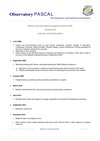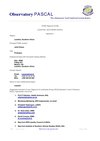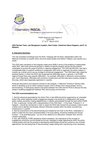Lesotho
The Kingdom of Lesotho is a landlocked, mountainous country surrounded by South Africa, in the south east of the continent. Situated 1000 metres above sea level, it is one of the coldest regions in the global South, with temperatures normally ranging from minus five in winter to a mere 28 degrees in summer. The capital Maseru is situated in the lowlands to the West, while the highlands in the East extend to more than 2,500 metres above sea level.
A formerly colonized country under British Protectorate, Lesotho gained its independence in 1966, though it has always been in the shadow of South Africa and South Africa’s own political history. Lesotho suffered a generation of political discord and upheavals before reverting to a parliamentary democracy in 1998. Although its population is only 2 million, at least as many Basotho (Lesotho citizens) live outside the country and a large minority of male wage earners (35%) still commute to South Africa for work, though this number has decreased sharply since the late 1990s. UNICEF’s (2008) country statistics indicate that the population is almost entirely homogeneous with almost everyone speaking the national language of Sesotho, though a few communities to the East have Khosa or Zulu as their first language. Only .03% are non-Sotho in origin. The main religion is Christian (80%) with some 20% practising indigenous beliefs.
Eighty six percent of the economy is subsistence agriculture and 14% industrial. Agricultural production consists of corn, wheat, pulses, sorghum, barley and livestock, while industries include food beverages, textiles, handicrafts, tourism, apparel assembly and construction. Traditional, labour intensive farming practices prevail and this includes shared crop farming, whereby communities assist each other at harvest and ploughing times to maximise production. Arable land is decreasing due to soil erosion and climate change. Natural resources are primarily water, sand, clay and stone, with some diamonds. Unemployment officially stands at 46%, with 35% identified as living on less than $1 a day. Lesotho suffers from one of the highest HIV prevalancies in the world with official figures identifying the prevalence rate as 23.2% and a consequent life expectancy of only 34.5 years (UNICEF 2008). Less than 8% had access to electricity and only 8% had telephone lines in 2005 (GOL 2005a). Whilst road networks are improving it is not yet possible to drive all the way through the mountainous regions on tarred road.
Lesotho’s economy has historically been dependent largely on the Republic of South Africa (RSA). Until 1990, the remittances from Basotho mine-workers employed in RSA contributed almost 50% of the Gross National Income (GNI). However, there was a sharp decline in mining opportunities for Basotho in the 1990s and less than 20% of the GNI is now generated in RSA, largely through migrant labour. The garment industry, which sprung up to take advantage of preferential access to the US market under the African Growth and Opportunities Act (AGOA), has typically provided low-wage employment to Basotho, most of them women. However, this industry also shed 15,000 jobs in 2005, squeezed by competition from highvolume Asian producers.
Drought and unemployment have rendered more than half the population dependent on food assistance. Like many countries in Southern Africa, Lesotho has been badly affected by the HIV and AIDS pandemic, with 28.9% of the country’s adults aged between 15 and 49 said to be living with HIV and AIDS. As a result of the pandemic, the number of vulnerable people in need of emergency food aid rose from 448,000 to nearly 700,000 or one-third of the population between 2002 and 2004, with the number of orphans estimated to be about 180,000 in 2005 (UNICEF, 2007).
 Printer-friendly version
Printer-friendly version- 245 reads











